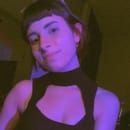María Lulu Varona is a Puerto Rican contemporary artist who specializes in visual storytelling through cross stitching, and whose work has been exhibited in New York, Mexico City and San Juan. She’s also someone I’ve had the pleasure to meet and work with through a performance art course at the University of Puerto Rico, Río Piedras Campus. Recently, I had the opportunity to interview her about her creative process, her colorful narratives, and her experience at her first solo exhibition at Embajada, an alternative art space in Santurce, Puerto Rico.
Sofía Capllonch: How did you come across cross-stitching?
Lulu Varona: I spent a lot of time with my grandmother after school and on weekends. She cross-stitched often, which is why she taught me after noticing my interest in the craft. I stitched my first piece 10 years ago and I still have it. It’s a rose. Then, when I was nineteen, I decided that I wanted to craft a gift for my partner at the time. We both had a fascination for comics, so I decided to return to this practice I learned when I was little and stitch him a comic.
You work a lot with comic strips to tell gradually-evolving stories. Do you establish these narratives before getting to work or do they evolve through the process?
One thing leads to another. As I’m stitching, I create the stories; that’s how they’re done. I’m always stitching the squares, and depending on that is essentially how the story evolves. I don’t say, for example, I’m gonna create a story on just nine panels. It’s simply not predetermined.
What themes do you explore through your stories?
I work a lot with the themes of transformations and evolution of the self. I also create more abstract narratives with cohesive continuity, with the intention of communicating existential concerns as a way to speak about how I relate to my surroundings.
You’re also a musician, which is amazing. Do you draw inspiration from music or other creative fields? Are there other art forms you’re currently exploring?
I would say yes; more than music even, I’m inspired by the performing arts, performance art and contemporary dance. Even though I work mostly on cross-stitching, I’m interested in expanding my knowledge in other disciplines, particularly the art we’re discussing in class: performance art that comes from the body. It’s like a challenge.
How would you describe your art in a sentence?
Technically, my art can be considered as these performative pieces that take a long time to makeーan intense and laborious practice that seeks to create a calm space.
There’s something playful and nostalgic about your works, almost like they’re referencing old-school 80’s video games. Are video games an influence?
That’s just how the technique goesーyou work on a pixel grid. My original intention wasn’t to allude to these video games; the association is something that’s happened naturally because people can relate more to 8-bit video games than to cross-stitching.
What was the creative process like during the pandemic?
I worked a lot. I did stitch, but I focused more on stitching words instead of mapping out stories. Just before the pandemic started, I bought a mundillo (a cylindrical pillow used to weave lace as part of a traditional Puerto Rican lacemaking practice of the same name) and started taking mundillo lessons, so the pandemic gave me a chance to focus on that. It’s a technique I’ve been working on for little more than a year. It’s relatively new to me, so it’s like another world completely.
How would you describe the experience of having your first solo show, LABOR-DADA at Embajada?
Well, it was very good, very special. It was exhibited for several months, so more people could see my work; which is great because that way it’s more accessible. In more informal words, it gives you clout. Curators from other countries see you, and in that sense it was very beneficial for my career.
Out of all the works presented in the show, which one would you say was the most significant to you?
The Scrolls. It’s a very simple story of a pair of legs, told in two parts. It’s a very personal story that talks about how a person is formed through their experiences; how we are formed as human beings and the things with which we constantly interact.
Speaking about the exhibition, you also showcased a deconstruction of a word; specifically, trap artist Anuel AA’s notorious catchphrase Brrrr. Why did you choose to explore this particular word?
I chose Anuel and his phrase because of how violent his words are. It’s a way to represent the marginalized reality here in Puerto Rico, where, for many people, it feels like a constant war. It’s also a way to show how local trap artists glorify themselves. For example, this phrase is absurd and violent, because it references firearms being shot.
You also showcased Mapa, a kaleidoscopic tapestry depicting some of the recent events Puerto Rico has gone through, such as protests and hurricanes. What motivated you to create it?
After Hurricane María, I moved to New York and began stitching the piece over there; it was a gesture to reconnect with Puerto Rico; a narration of the events that displace me to the places that I go to and that influence me as well. It’s also a way to represent pictorially all the disasters we’ve had to live through as Puerto Ricans, both inside the Island and out.
What is your greatest goal as an artist?
To have my art take me to know other parts of the world, but also to educate myself and contribute knowledge here, as there’s an evident lack of textile practices… I really like this question, because I’ve actually been thinking about my goals a lot. For me, it’s also very important in life to be at peace with myself, to be honest and respectful with myself and others.


